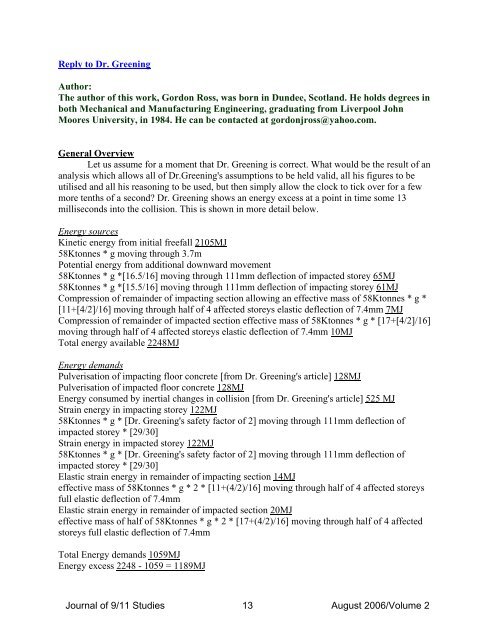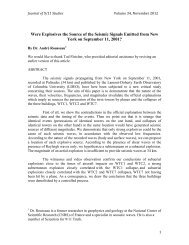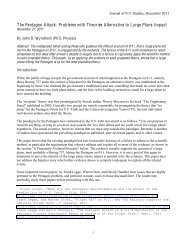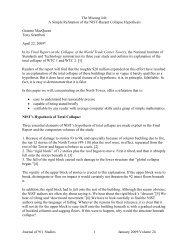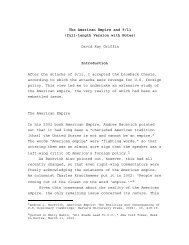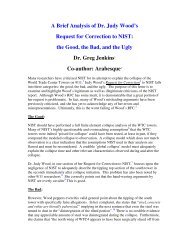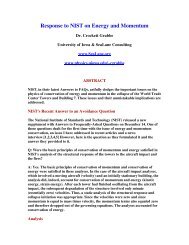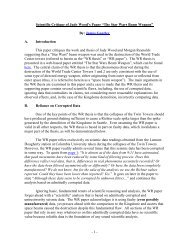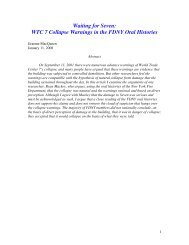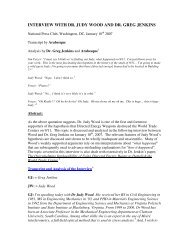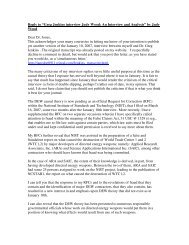Reply to Dr. Greening - Journal of 9/11 Studies
Reply to Dr. Greening - Journal of 9/11 Studies
Reply to Dr. Greening - Journal of 9/11 Studies
You also want an ePaper? Increase the reach of your titles
YUMPU automatically turns print PDFs into web optimized ePapers that Google loves.
<strong>Reply</strong> <strong>to</strong> <strong>Dr</strong>. <strong>Greening</strong><br />
Author:<br />
The author <strong>of</strong> this work, Gordon Ross, was born in Dundee, Scotland. He holds degrees in<br />
both Mechanical and Manufacturing Engineering, graduating from Liverpool John<br />
Moores University, in 1984. He can be contacted at gordonjross@yahoo.com.<br />
General Overview<br />
Let us assume for a moment that <strong>Dr</strong>. <strong>Greening</strong> is correct. What would be the result <strong>of</strong> an<br />
analysis which allows all <strong>of</strong> <strong>Dr</strong>.<strong>Greening</strong>'s assumptions <strong>to</strong> be held valid, all his figures <strong>to</strong> be<br />
utilised and all his reasoning <strong>to</strong> be used, but then simply allow the clock <strong>to</strong> tick over for a few<br />
more tenths <strong>of</strong> a second <strong>Dr</strong>. <strong>Greening</strong> shows an energy excess at a point in time some 13<br />
milliseconds in<strong>to</strong> the collision. This is shown in more detail below.<br />
Energy sources<br />
Kinetic energy from initial freefall 2105MJ<br />
58K<strong>to</strong>nnes * g moving through 3.7m<br />
Potential energy from additional downward movement<br />
58K<strong>to</strong>nnes * g *[16.5/16] moving through <strong>11</strong>1mm deflection <strong>of</strong> impacted s<strong>to</strong>rey 65MJ<br />
58K<strong>to</strong>nnes * g *[15.5/16] moving through <strong>11</strong>1mm deflection <strong>of</strong> impacting s<strong>to</strong>rey 61MJ<br />
Compression <strong>of</strong> remainder <strong>of</strong> impacting section allowing an effective mass <strong>of</strong> 58K<strong>to</strong>nnes * g *<br />
[<strong>11</strong>+[4/2]/16] moving through half <strong>of</strong> 4 affected s<strong>to</strong>reys elastic deflection <strong>of</strong> 7.4mm 7MJ<br />
Compression <strong>of</strong> remainder <strong>of</strong> impacted section effective mass <strong>of</strong> 58K<strong>to</strong>nnes * g * [17+[4/2]/16]<br />
moving through half <strong>of</strong> 4 affected s<strong>to</strong>reys elastic deflection <strong>of</strong> 7.4mm 10MJ<br />
Total energy available 2248MJ<br />
Energy demands<br />
Pulverisation <strong>of</strong> impacting floor concrete [from <strong>Dr</strong>. <strong>Greening</strong>'s article] 128MJ<br />
Pulverisation <strong>of</strong> impacted floor concrete 128MJ<br />
Energy consumed by inertial changes in collision [from <strong>Dr</strong>. <strong>Greening</strong>'s article] 525 MJ<br />
Strain energy in impacting s<strong>to</strong>rey 122MJ<br />
58K<strong>to</strong>nnes * g * [<strong>Dr</strong>. <strong>Greening</strong>'s safety fac<strong>to</strong>r <strong>of</strong> 2] moving through <strong>11</strong>1mm deflection <strong>of</strong><br />
impacted s<strong>to</strong>rey * [29/30]<br />
Strain energy in impacted s<strong>to</strong>rey 122MJ<br />
58K<strong>to</strong>nnes * g * [<strong>Dr</strong>. <strong>Greening</strong>'s safety fac<strong>to</strong>r <strong>of</strong> 2] moving through <strong>11</strong>1mm deflection <strong>of</strong><br />
impacted s<strong>to</strong>rey * [29/30]<br />
Elastic strain energy in remainder <strong>of</strong> impacting section 14MJ<br />
effective mass <strong>of</strong> 58K<strong>to</strong>nnes * g * 2 * [<strong>11</strong>+(4/2)/16] moving through half <strong>of</strong> 4 affected s<strong>to</strong>reys<br />
full elastic deflection <strong>of</strong> 7.4mm<br />
Elastic strain energy in remainder <strong>of</strong> impacted section 20MJ<br />
effective mass <strong>of</strong> half <strong>of</strong> 58K<strong>to</strong>nnes * g * 2 * [17+(4/2)/16] moving through half <strong>of</strong> 4 affected<br />
s<strong>to</strong>reys full elastic deflection <strong>of</strong> 7.4mm<br />
Total Energy demands 1059MJ<br />
Energy excess 2248 - 1059 = <strong>11</strong>89MJ<br />
<strong>Journal</strong> <strong>of</strong> 9/<strong>11</strong> <strong>Studies</strong> 13 August 2006/Volume 2
The falling upper section, according <strong>to</strong> <strong>Dr</strong>. <strong>Greening</strong>'s analysis, remains able and<br />
equipped <strong>to</strong> continue <strong>to</strong> progress the collapse, and it will do so by continuing <strong>to</strong> accelerate the<br />
<strong>to</strong>wer downwards and deforming the support columns. The most immediate task that it will face<br />
in doing so will be <strong>to</strong> continue the acceleration <strong>of</strong> those floors identified by <strong>Dr</strong>. <strong>Greening</strong> as<br />
being first affected by the collapse as it attempts <strong>to</strong> reconcile and satisfy the laws <strong>of</strong> conservation<br />
<strong>of</strong> momentum and energy. The upper section will also continue <strong>to</strong> act on the first impacted and<br />
impacting column sections by moving these through the remainder <strong>of</strong> their elastic strain phase<br />
and in<strong>to</strong> the plastic phase range. This will consume energy and take time. Again assuming a<br />
continued constant velocity <strong>of</strong> 8.5m/sec the further movement through the plastic deflection <strong>of</strong><br />
four s<strong>to</strong>reys 444mm will take another 50 milliseconds.<br />
Using the velocity <strong>of</strong> force propagation proposed by <strong>Dr</strong>. <strong>Greening</strong> which saw the force<br />
being felt at five s<strong>to</strong>reys from the collision in the first 13 milliseconds, then we can deduce that<br />
in the next 50 milliseconds the influence <strong>of</strong> the force exerted by the falling mass will be felt over<br />
a further 20 s<strong>to</strong>reys. The falling section will now tend <strong>to</strong>wards a velocity given by the formula<br />
v1[m1 / [m1 + m2]] = 8.52 * [16 / (16 + 5 + {20/2})] = 4.4 m/second. The kinetic energy will<br />
now be embodied in the original 16 s<strong>to</strong>reys, plus the five s<strong>to</strong>reys under plastic loading, and the<br />
twenty s<strong>to</strong>reys under elastic loading. This <strong>to</strong>tal kinetic energy, should, according <strong>to</strong> <strong>Dr</strong>.<br />
<strong>Greening</strong>, now be regarded as being available at the collapse front, and is calculated as now<br />
being only some 52% <strong>of</strong> its original energy input from the freefall initiation. Thus all <strong>of</strong> the<br />
kinetic energy, even that in the lowermost s<strong>to</strong>ries is regarded as being available <strong>to</strong> progress the<br />
collapse front, and the energy balance can now be examined for this point in time <strong>of</strong> the collapse.<br />
Energy sources<br />
Kinetic energy from initial freefall 2105MJ<br />
58K<strong>to</strong>nnes * g moving through 3.7m<br />
Potential energy from additional downward movement<br />
58K<strong>to</strong>nnes * g *[16.5/16] moving through 555mm deflection <strong>of</strong> impacted s<strong>to</strong>rey 325MJ<br />
58K<strong>to</strong>nnes * g *[15.5/16] moving through 555mm deflection <strong>of</strong> impacting s<strong>to</strong>rey 305MJ<br />
Compression <strong>of</strong> remainder <strong>of</strong> impacting section allowing an effective mass <strong>of</strong> 58K<strong>to</strong>nnes * g *<br />
[[<strong>11</strong>/2]/16] moving through a proportion <strong>of</strong> <strong>11</strong> affected s<strong>to</strong>reys elastic deflections <strong>of</strong> 7.4mm<br />
13MJ<br />
Compression <strong>of</strong> remainder <strong>of</strong> impacted section effective mass <strong>of</strong> 58K<strong>to</strong>nnes * g * [17+[5/2]/16]<br />
moving through half <strong>of</strong> 20 affected s<strong>to</strong>reys elastic deflection <strong>of</strong> 7.4mm 52MJ<br />
Total energy available 2700MJ<br />
Energy demands<br />
Pulverisation <strong>of</strong> impacting floor concrete 128MJ<br />
Pulverisation <strong>of</strong> impacted floor concrete 128MJ<br />
Energy consumed by inertial changes in collision 1010MJ<br />
Strain energy in impacting s<strong>to</strong>rey 710MJ<br />
58K<strong>to</strong>nnes * g * [<strong>Dr</strong>. <strong>Greening</strong>'s safety fac<strong>to</strong>r <strong>of</strong> 2] moving through 555mm deflection <strong>of</strong><br />
impacted s<strong>to</strong>rey * [29/30]<br />
Strain energy in impacted s<strong>to</strong>rey 710MJ<br />
<strong>Journal</strong> <strong>of</strong> 9/<strong>11</strong> <strong>Studies</strong> 14 August 2006/Volume 2
58K<strong>to</strong>nnes * g * [<strong>Dr</strong>. <strong>Greening</strong>'s safety fac<strong>to</strong>r <strong>of</strong> 2] moving through 555mm deflection <strong>of</strong><br />
impacted s<strong>to</strong>rey * [29/30]<br />
Elastic strain energy in remainder <strong>of</strong> impacting section 26MJ effective mass <strong>of</strong> 58K<strong>to</strong>nnes * g *<br />
2 * [(<strong>11</strong>/2)/16] moving through a proportion <strong>of</strong> <strong>11</strong> affected s<strong>to</strong>reys' full elastic deflection <strong>of</strong><br />
7.4mm<br />
Elastic strain energy in remainder <strong>of</strong> impacted section 104MJ effective mass <strong>of</strong> half <strong>of</strong><br />
58K<strong>to</strong>nnes * g * 2 * [17+(4/2)/16] moving through half <strong>of</strong> 4 affected s<strong>to</strong>reys' full elastic<br />
deflection <strong>of</strong> 7.4mm<br />
Total Energy demands 2816MJ<br />
Energy deficit 2816 - 2700 = <strong>11</strong>6MJ<br />
This shows that by using the same reasoning and analysis as <strong>Dr</strong>. <strong>Greening</strong> and by<br />
adopting the figures proposed by him, the upper section can be shown <strong>to</strong> have been exhausted at<br />
a point in time prior <strong>to</strong> completion <strong>of</strong> the shortening phase <strong>of</strong> the buckle failures induced in only<br />
those columns identified by <strong>Dr</strong>.<strong>Greening</strong> as being the first affected by the collapse. This analysis<br />
shows that the collapse would progress for a further 50 milliseconds, beyond the point that was<br />
predicted in my article, before suffering arrest. Should the collapse be somehow enabled <strong>to</strong><br />
continue, the energy demands will continue <strong>to</strong> present themselves. The 20 s<strong>to</strong>reys now identified<br />
as feeling the effects <strong>of</strong> the collision will require energy <strong>to</strong> facilitate their downward movement<br />
and acceleration and the 3% plastic shortening <strong>of</strong> the columns will continue <strong>to</strong> present a demand<br />
until the minimum buckle length is reached. Other demands begin <strong>to</strong> become apparent such as<br />
disconnection <strong>of</strong> the floor connections and importantly, the disconnection <strong>of</strong> two vertical failure<br />
lines within the spandrel plates and core bracing at and about each corner <strong>to</strong> allow perpendicular<br />
buckle movements. The energy demands will <strong>of</strong>fer no respite <strong>to</strong> the falling section especially as<br />
the order <strong>of</strong> the collapse is lost with the advancement <strong>of</strong> time and continually growing assymetry.<br />
Kinetic Energy<br />
If we take <strong>Dr</strong>. <strong>Greening</strong>'s ratio <strong>of</strong> 1.77 derived from the ratio <strong>of</strong> velocities and multiply<br />
by the number <strong>of</strong> s<strong>to</strong>reys in the impacting section, 16, we find that this gives 28.5 which is<br />
exactly the same as the mass which I did use. This is not surprising since it was from this figure<br />
that the velocity ratio was worked out in the first place. This is a circular argument evidently<br />
arising from <strong>Dr</strong>. <strong>Greening</strong>'s misunderstanding. <strong>Dr</strong>. <strong>Greening</strong> seems <strong>to</strong> be concerned that the<br />
collapse will continue due <strong>to</strong> the kinetic energy already transferred from the upper section <strong>to</strong> the<br />
first impacted s<strong>to</strong>reys. The energy being considered is originally embodied throughout the upper<br />
impacting section and on impact it will be partly transferred from that section and consumed by<br />
acceleration <strong>of</strong> the impacted masses involved and in elastic and plastic strain energy within the<br />
support columns. The strain energies have been separately accounted. The kinetic energy, after<br />
collision, <strong>of</strong> the columns undergoing plastic deformation has already been included in the<br />
analysis as being available <strong>to</strong> the collision.<br />
Only the kinetic energy <strong>of</strong> those columns undergoing partial elastic deformation has been<br />
regarded as being unavailable at the collapse front. Since this energy has already passed below<br />
and beyond the area <strong>of</strong> plastic deformation and is now embodied in kinetic energy in a mass<br />
moving away from the collapse front it cannot be regarded as being able <strong>to</strong> act in a compressive<br />
<strong>Journal</strong> <strong>of</strong> 9/<strong>11</strong> <strong>Studies</strong> 15 August 2006/Volume 2
manner at the collapse front. It does not cause predamage as <strong>Dr</strong>. <strong>Greening</strong> points out, the strain<br />
energies <strong>of</strong> any damage are separately accounted. Being a kinetic energy it has the ability <strong>to</strong><br />
cause damage only upon deceleration.<br />
As energy consumption at the collapse front begins <strong>to</strong> exhaust the energy available <strong>to</strong> the<br />
crushing mass, it will decelerate <strong>to</strong> such an extent as <strong>to</strong> then allow the elastic strain in the<br />
columns <strong>to</strong> act upwards against the kinetic energy in the floors and columns. The inertia <strong>of</strong> these<br />
columns would continue the elastic deflection <strong>of</strong> lower s<strong>to</strong>reys, the kinetic energy will thus<br />
continue <strong>to</strong> spread downwards as the columns search for new equilibrium positions, and there<br />
would undoubtedly be a bounce and vibrations set up but with the opposing force now being<br />
reduced <strong>to</strong> only the static mass <strong>of</strong> the upper section, any possible return <strong>of</strong> kinetic energy from<br />
the lower s<strong>to</strong>reys back <strong>to</strong> the collision front will not result in continued compression but rather as<br />
a lifting <strong>of</strong> the upper section, an increase in potential energy.<br />
Concrete Pulverisation<br />
Concrete pulverisation was immaterial <strong>to</strong> the initial argument <strong>of</strong> whether the collapse<br />
would be arrested or continue. It was included as indicative <strong>of</strong> the energies required and showed<br />
the early arrest <strong>of</strong> the collapse, but if considered as zero the collapse would have been arrested<br />
within the next few tenths <strong>of</strong> a second as the strain energy requirements instead drained the<br />
energy supply <strong>of</strong> the impacting mass. I specifically chose the analysis by <strong>Dr</strong>. <strong>Greening</strong> so as <strong>to</strong><br />
avoid unnecessary debate on this important but not directly considered aspect.<br />
However, regarding <strong>Dr</strong>. <strong>Greening</strong>'s new analysis there are one or two points which are<br />
worth examining. The analysis using 5MPa and 8.5m/sec would use up 128 MJ for one floor,<br />
but an average collision would have 20 MPa and 35m/sec, so this would roughly give a <strong>to</strong>tal<br />
consumption for the pulverisation <strong>of</strong> concrete throughout the <strong>to</strong>wer <strong>of</strong> 220GJ.<br />
We know that the potential energy <strong>of</strong> the <strong>to</strong>wer was roughly 1000GJ. We also know that a<br />
momentum only analysis <strong>of</strong> a <strong>to</strong>wer <strong>of</strong> equal s<strong>to</strong>rey mass would give the collapse front<br />
progressing from initiation level <strong>to</strong> the ground level in just under 12 seconds and reaching a<br />
velocity <strong>of</strong> 52m/sec. This would give a remaining kinetic energy <strong>of</strong> 690 GJ using a mass <strong>of</strong> 510<br />
k<strong>to</strong>nnes. A similar analysis <strong>of</strong> a <strong>to</strong>wer whose mass more emulates the <strong>to</strong>wer would show 13.5<br />
seconds, reaching 46m/sec and having kinetic energy <strong>of</strong> 540GJ. To remove 220GJ from this<br />
figure in order <strong>to</strong> pulverise the concrete would leave only 320GJ and this would indicate a<br />
collapse front <strong>of</strong> 17.5 seconds taking in<strong>to</strong> regard only the energies consumed in momentum<br />
changes and in pulverisation <strong>of</strong> concrete. None <strong>of</strong> the energies required <strong>to</strong> dis<strong>to</strong>rt any <strong>of</strong> the steel<br />
structure, nor <strong>to</strong> pulverise the remainder <strong>of</strong> the <strong>to</strong>wer construction materials or contents, nor <strong>to</strong><br />
disperse the debris and dust, nor any <strong>of</strong> the other energy demands and sinks associated with the<br />
collapse, are included in this figure <strong>of</strong> 17.5 seconds, only the inherent momentum demands and<br />
the pulverisation <strong>of</strong> the concrete.<br />
Force Propagation<br />
It is noted that <strong>Dr</strong>. <strong>Greening</strong> accepts that the force will propagate ahead <strong>of</strong> the movement<br />
<strong>of</strong> the collapse front.<br />
<strong>Journal</strong> <strong>of</strong> 9/<strong>11</strong> <strong>Studies</strong> 16 August 2006/Volume 2
The first question which must be asked is, if the force could not be transferred further<br />
than five s<strong>to</strong>reys away from the collapse front in the time allowed, as <strong>Dr</strong>. <strong>Greening</strong> argues, how<br />
was it possible for the force from the hat truss and upper ten s<strong>to</strong>reys <strong>to</strong> be transferred further than<br />
five s<strong>to</strong>reys in the same time allowed, in order <strong>to</strong> act at the collapse front If the velocity <strong>of</strong> the<br />
force propagation was as low as <strong>to</strong> only affect five s<strong>to</strong>reys <strong>to</strong> a proportion <strong>of</strong> their elastic limit,<br />
then the same strictures must be applied <strong>to</strong> the force arising from those masses which are being<br />
applied by the collapse front. The effective mass under these circumstances would only be that<br />
arising from about 3/16 <strong>of</strong> the 58 k<strong>to</strong>nnes <strong>of</strong> the upper section. Logic should dictate that the<br />
velocity <strong>of</strong> propagation would be such as <strong>to</strong> ensure that by the time the effect <strong>of</strong> the mass <strong>of</strong> the<br />
<strong>to</strong>p s<strong>to</strong>rey, some sixteen s<strong>to</strong>reys from the collapse front was fully engaged in the collision then<br />
the effects <strong>of</strong> the first impacting s<strong>to</strong>rey would be also felt at sixteen s<strong>to</strong>reys from the collapse<br />
front.<br />
<strong>Dr</strong>. <strong>Greening</strong> suggests that the tilting <strong>of</strong> the upper section gave rise <strong>to</strong> lateral forces which<br />
aided the collapse and there are undoubtedly many aspects <strong>of</strong> the collapse which do require<br />
further analysis. I intend <strong>to</strong> address some <strong>of</strong> these points in a further article dealing with the<br />
mechanics <strong>of</strong> the collapse, and the strange behaviour <strong>of</strong> the upper section demands attention<br />
among several other aspects. With regard <strong>to</strong> this analysis the tilting <strong>of</strong> this <strong>to</strong>wer was small and<br />
reached only about 2 degrees in the first second. This would give a horizontal reaction <strong>to</strong> applied<br />
vertical forces but this would be in the relation <strong>of</strong> the sine <strong>of</strong> the angle and at 2 degrees, this<br />
would give a maximum <strong>of</strong> only 3% <strong>of</strong> the applied force after about one second. It is safe <strong>to</strong><br />
exclude the effects <strong>of</strong> this small lateral force in these early stages especially when it is<br />
remembered that the analysis excludes all other lateral strains. Were these <strong>to</strong> be included then the<br />
largest lateral strains would be those within the vertical columns occasioned by the vertical<br />
forces. If a vertical force is applied <strong>to</strong> a column it will set up stresses in the axis through which it<br />
is applied but also in the two perpendicular directions. These stresses will be proportional <strong>to</strong> the<br />
applied stresses and can be calculated using Poisson’s ratio. With a typical value <strong>of</strong> 0.28 for<br />
Poisson’s ratio <strong>of</strong> steel we can very easily see that these lateral strains would amount <strong>to</strong> almost<br />
60% <strong>of</strong> all the elastic and plastic strains identified by the analysis, some 360MJ added <strong>to</strong> the<br />
energy deficit in my analysis. If these lateral strains were included in the analysis the energy<br />
balance would reach exhaustion at an earlier stage.<br />
We know that the column end connection were able <strong>to</strong> propagate loads efficiently<br />
because they were already pre-loaded with the static load <strong>of</strong> the structure above, thus<br />
demonstrating the previous integrity and viability <strong>of</strong> the connections.<br />
In my article I used only a second iteration <strong>to</strong> show the number <strong>of</strong> floors taking part in the<br />
momentum and velocity changes <strong>of</strong> the collision. A full iteration would give about 30 s<strong>to</strong>reys,<br />
and allowing that the falling mass was decelerated <strong>to</strong> half <strong>of</strong> its original velocity would allow<br />
time for the propagation <strong>to</strong> extend loading <strong>to</strong> more than 40 s<strong>to</strong>reys below the impact. My<br />
assumptions have the affect <strong>of</strong> reducing the number <strong>of</strong> s<strong>to</strong>reys which take part. This <strong>to</strong>gether<br />
with the assumption that only a portion <strong>of</strong> the elastic deflection will apply underestimates the<br />
energy requirements <strong>of</strong> this task and makes abundant compensation for any possible losses in the<br />
velocity <strong>of</strong> propagation.<br />
Conclusion<br />
<strong>Journal</strong> <strong>of</strong> 9/<strong>11</strong> <strong>Studies</strong> 17 August 2006/Volume 2
<strong>Dr</strong> <strong>Greening</strong> states, "Certainly, if Ross’ suggestion that 24 floors below about the 95th<br />
floor moved downward after the impact <strong>of</strong> the upper section, the videos and pho<strong>to</strong>graphs <strong>of</strong> the<br />
collapse <strong>of</strong> WTC should show a noticeable downward displacement <strong>of</strong> floors between the 70 th<br />
and 94 th levels immediately after the impact. In fact, no such movement was observed. "<br />
My analysis showed that a gravity only collapse would produce a "noticeable downward<br />
displacement" and an arrest. I would argue that the absence <strong>of</strong> a noticeable downward<br />
displacement is less significant than the very noticeable absence <strong>of</strong> arrest. Since neither was<br />
observed then logic would dictate that either the analysis is wrong or it was not a gravity-only<br />
collapse.<br />
By adopting <strong>Dr</strong>. <strong>Greening</strong>'s own arguments, corrections, contentions, figures and<br />
reasoning, the analysis once again shows that the collapse would be arrested at an early stage.<br />
<strong>Dr</strong>. <strong>Greening</strong> has not disproved the logic and conclusions <strong>of</strong> my article, but has in fact<br />
reinforced the most important conclusion: that collapse would have been arrested at an early<br />
stage.<br />
Further doubt has been cast on a gravity-driven collapse using the analysis <strong>Dr</strong>.<br />
<strong>Greening</strong> has provided in reference <strong>to</strong> the pulverisation <strong>of</strong> the concrete. Combining this<br />
with our knowledge <strong>of</strong> the theoretical minimum collapse time having regard only <strong>to</strong><br />
momentum transfer, it is shown that a collapse time <strong>of</strong> 17.5seconds, is the theoretical<br />
minimum collapse time having regard only <strong>to</strong> the momentum transfers and the concrete<br />
pulverisation. This timing contrarily does not take regard <strong>of</strong> the loss <strong>of</strong> effective mass that<br />
would be present due <strong>to</strong> the pulverisation and the ejection <strong>of</strong> the concrete pieces outside the<br />
area where they play a role in promulgating the collapse. Having regard <strong>to</strong> this and the<br />
other energies involved, the theoretical minimum collapse time can be seen <strong>to</strong> be<br />
approaching double that <strong>of</strong> the figures given for the collapse timing in <strong>of</strong>ficial reports, even<br />
with no account taken <strong>of</strong> the energy demand from the dis<strong>to</strong>rtion and destruction wrought<br />
<strong>to</strong> the steel superstructures.<br />
<strong>Journal</strong> <strong>of</strong> 9/<strong>11</strong> <strong>Studies</strong> 18 August 2006/Volume 2


